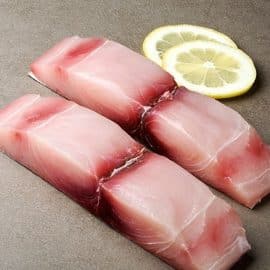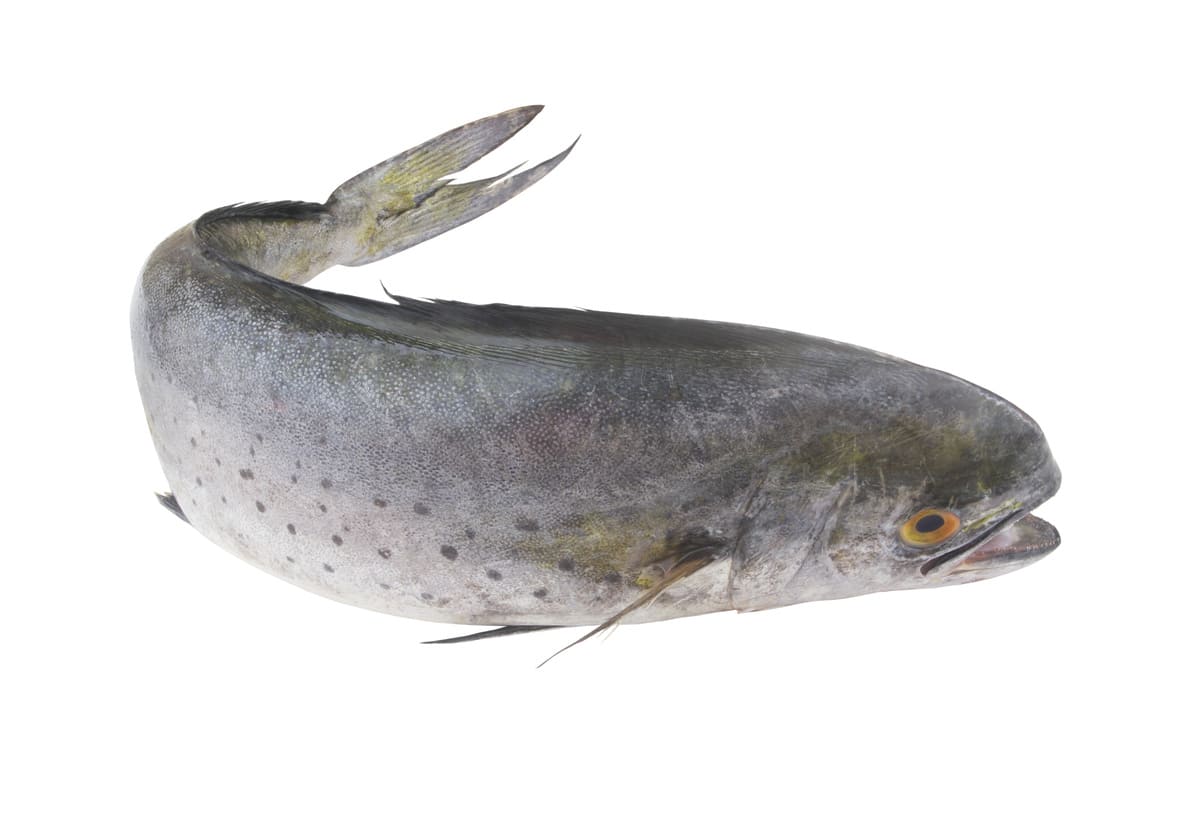
Introduction
Mahi Mahi, also known as the common or dorado dolphin fish, is an ocean-dwelling fish making a splash in culinary circles. If you like to eat fish, its flesh is prized for its texture and flavour and is increasingly sought-after by restaurants worldwide. It has become so popular that over 6 million tons of mahi mahi are fished yearly from the sea.
Description & Characteristics
Mahi Mahi is easily identified by its distinctive shapes and vivid colours, which include blues, greens, yellows and oranges. The body is typically cylindrical with a distinctively high dorsal fin and long spiky pectoral fins. It can reach lengths of up to 1.5 meters and weights of up to 30 kilograms.
It has a vibrant blue and green colouration that captivates onlookers from all ocean corners. Its species name Coryphaena hippurus translates to “brave wave rider”, aptly describing this creature’s strength and ability to ride the waves.
Mahi Mahi is carnivores that feed on other fish, such as small tuna and squid, as well as crustaceans like shrimp and crabs. They travel in schools during the day but become solitary at night, often swimming near the surface to feed on planktonic organisms.
They are one of the fastest-swimming fish in the ocean and have been recorded at speeds of up to 55 kilometres per hour.
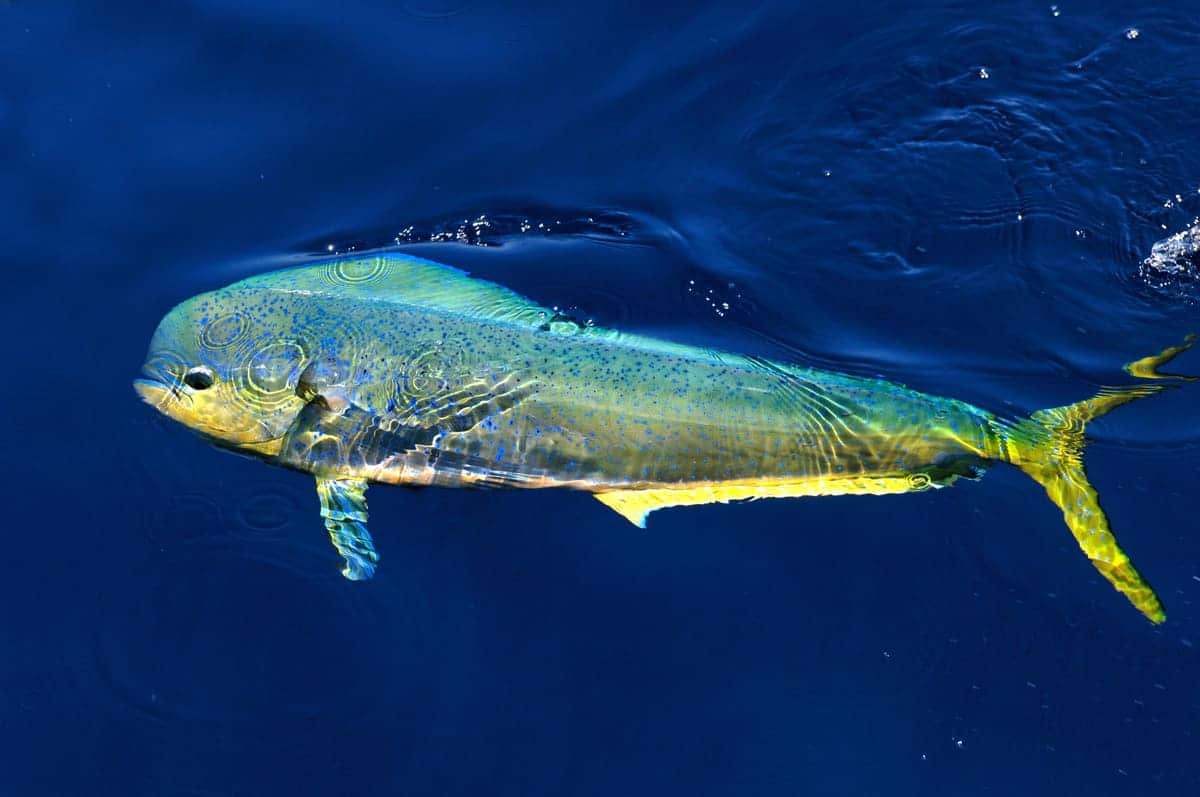
Species And Taxonomy
Taxonomically speaking, mahi mahi are classified in the family of Coryphaenidae and the genus of Coryphaena. Their size distinguishes them – they can grow up to 1.5m long but usually reach around 60 cm in length – their large mouths, prominent lower jaws, and their two dorsal fins, one long-based and one short-based. Their bodies are covered with tiny scales that easily rub off when handled.
Etymology
The etymology of the term ‘mahi mahi’ is like a puzzle with many pieces and interpretations. As the sun rises in the sky, it illuminates the many mysteries of its origin. Like a kaleidoscope, different cultures have different versions of how to say ‘mahi mahi’. In Hawaiian, this term translates as ‘strong-strong’ or ‘very strong’; other Pacific islanders refer to it as dorado or dolphin fish. It may be called lampuka in Malta, calitos in Panama and Spain, and maan-maan in parts of the Caribbean. Along similar lines, some Afro-Caribbean speakers call it dorade coryphène.
Biology
The biology of Mahi Mahi is as captivating and dazzling as the fish itself. Like a fish out of water, Mahi Mahi is acrobatic predators, using their powerful tails to launch themselves out of the water in pursuit of prey. Their streamlined bodies boast impressive speed and agility in the water, with some species reaching speeds of up to 55mph.
Mahi Mahi has two distinct dorsal fins and a pronounced curved lateral line which they use to sense vibrations in the water column. They also possess an elongated upper jaw, giving them a unique profile. This feature helps them detect small prey items, such as plankton, that are otherwise difficult to locate. Additionally, their large eyes allow them to see movement in low-light environments.
Habitat And Distribution
Biologists are interested in learning more about the habitat and distribution of Mahi Mahi. There are several oceans where this species can be found, including the Atlantic, Pacific, and Indian Oceans, as well as the Caribbean Sea. It has also been observed along the coasts of North America, including the Gulf of Mexico and California. They prefer warm waters and usually live close to shore at depths between 200 to 1,000 feet (60-300 m). Although they are an oceanic species, they are also known to travel through estuaries and rivers for feeding purposes.
Mahi Mahi migrates seasonally, with their movements closely tied to water temperature changes. In the summer, they move farther north, and during winter, they move south. Their migration pattern is linked to the availability of prey which plays a vital role in their overall survival rate.
Mahi Mahi’s Diet
The allusion to the mahi mahi’s diet can be seen in its name, Mahi Mahi, a Hawaiian term meaning ‘very strong’. The reference alludes to the fish’s size, strength, and voracious appetite.
A mahi mahi is an apex predator that feeds on small aquatic creatures in its habitat. Its primary diet includes shrimp, squid, crabs, and small fish such as anchovies, sardines, and mackerels. It also eats other organisms, such as planktonic crustaceans and jellyfish.
Diet can vary depending on geographical location and seasonality. For example, some areas like the Gulf of Mexico or the Caribbean Sea feed primarily on sardines, while in other regions, they may consume more squid or crustaceans.
The diet of the mahi mahi changes with age; juvenile fish tend to eat the smaller prey, while adults will hunt more oversized prey items such as jacks and tuna. They are versatile predators that often hunt in groups and use cooperative feeding strategies to catch their prey efficiently. They may even use their tail fins to herd schools of baitfish into tighter concentrations before attacking them en masse.
Mahi Mahi also uses ambush tactics when hunting for larger prey by hiding among rocks or coral formations near their target. With few natural predators, this apex predator plays a vital role in controlling populations of their food sources, ensuring a balance is maintained within the marine ecosystem.
Life Cycle of Mahi Mahi
The life cycle of mahi mahi (Coryphaena hippurus) is relatively short but full of activity. Spawning occurs year-round in subtropical and tropical waters, with peak spawning occurring during summer.
Females release up to 1 million eggs per spawn, fertilised by males as they are released into the water column. The eggs hatch within a few days, and the larvae drift with ocean currents for several weeks before settling on coastal areas. During this time, they feed on plankton and proliferate, reaching sexual maturity at around one year old.
Mahi Mahi has an average lifespan of three to four years, although some individuals can live up to six or seven years in captivity. They reach their maximum size after about 18 months, at which point their growth rate slows significantly.
After reaching sexual maturity, adults will migrate to deeper offshore waters where they form schools and feed on larger prey such as squid and small fish. Here they remain until it is time to migrate back towards the shore again for spawning season.
Throughout their lives, mahi mahi are highly migratory species that may cover hundreds of miles over their lifetime as they search for food and new habitats.
Mahi Mahi Fisheries
Mahi Mahi is highly valued in commercial fisheries due to its large size, fast growth rate, and high-quality flesh. However, many fisheries face the challenge of overfishing and the potential for reduced catches. The sustainability of mahi mahi fisheries is a significant concern for managers, as overfishing can lead to decreased stock levels and reduced profits.
Sustainability
Sustainability is an important consideration for the fisheries of mahi mahi, a fish species in warm waters around the world. The abundance of this fish has decreased in many areas due to overfishing and other human activities, leading to calls for more sustainable management practices.
Several steps can be taken to ensure a sustainable harvest of mahi mahi. Firstly, regulations should be implemented to limit catch sizes and protect juveniles from being caught accidentally. Secondly, alternative fishing methods that minimise by-catch and habitat damage should be employed. Finally, data collection efforts should be improved to better understand the species’ population dynamics and allow for better management decisions.
In addition to these measures, stock assessment initiatives have been implemented in some regions to improve the accuracy of catch estimates and ensure that catch limits are not exceeded.
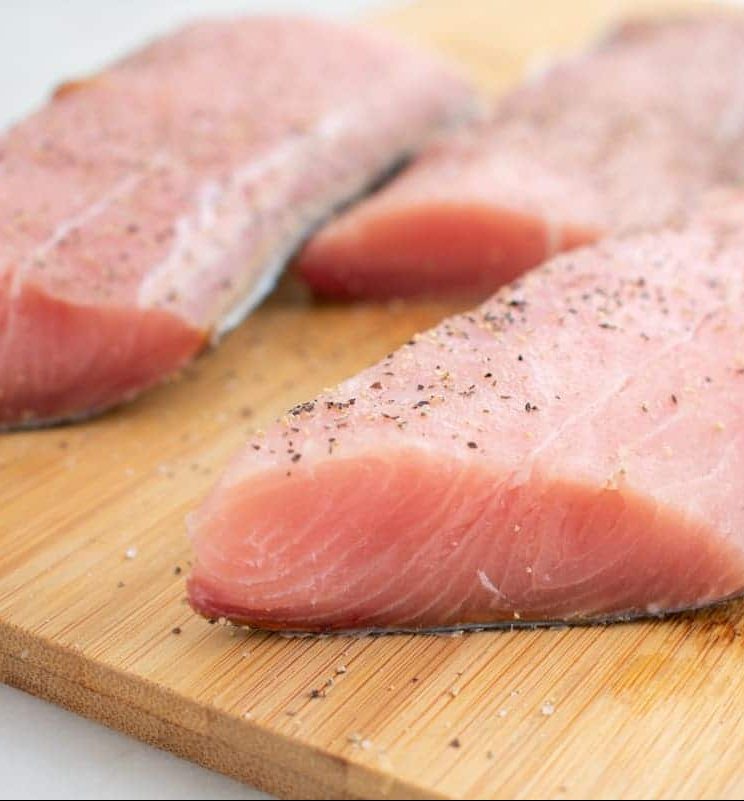
This includes assessing population size, age structure, reproductive status, and natural mortality rate through sampling techniques such as tagging studies. Also, there are specific minimum size limits for mahi mahi caught off the coasts to protect smaller fish.
Taking these precautionary measures makes it possible to maintain a healthy population of mahi mahi while allowing fishermen to continue harvesting their catches sustainably.
Mahi Mahi As Food
Mahi Mahi is a popular fish among chefs and diners alike, as it has a mild flavour and holds its shape after cooking. As food, mahi mahi is widely enjoyed for its mild taste and flaky texture when cooked. The fish has a sweet, buttery, and delicate flavour that pairs well with simple seasonings like lemon juice, salt, pepper, garlic, herbs and spices.
Several methods can be used to bring out the best flavours of this meaty seafood. From grilling to baking, here are the three most popular techniques for cooking mahi mahi:
Grilling: Grilling is the most common way to cook mahi mahi. This method is quick and simple yet brings out the intense flavour in the fish. Mahi mahi can be cooked whole, filleted, and skewered with lemon slices before grilling. When using this method, it is essential to pay attention to the heat and ensure not to overcook the fish.
Baking: Baking is another great way to prepare mahi mahi. This technique requires less attention than grilling and often results in more evenly cooked pieces of fish. For optimal results, first use a shallow pan with a bit of oil or butter sauce, lemon zest, and pan sear. Then bake the mahi mahi, ensuring it does not dry out during cooking.
Poaching: Poaching is another popular method for cooking this type of fish. This method causes less shrinkage and produces a delicate flavour with a tender texture. To poach your mahi mahi, place skinless fillets in a skillet filled with simmering liquid such as broth or white wine until cooked through; about 8 minutes per side, depending on the thickness of the fillet should do the trick!
Best Side Dishes Paired With Mahi Mahi
For those looking for something light yet flavorful, roasted vegetables make an excellent pairing with mahi mahi. Roasting brings out the natural sweetness of the vegetables and pairs well with the delicate flavours of the fish. Examples include sweet potatoes, carrots, asparagus, and squash. Additionally, adding herbs like oregano or thyme can add an extra layer of flavour.
Salads can be an excellent choice for those looking for something more substantial. Creating a salad with fresh ingredients such as tomatoes, cucumbers, peppers, and onions is an ideal way to bring out the subtle flavours of mahi mahi while providing texture and crunchiness.
Adding nuts like walnuts or almonds can enhance the dish’s flavour profile. To make it even more interesting, consider incorporating fruits such as oranges or apples into your salad for a touch of sweetness and acidity that will compliment mahi mahi perfectly:
1. Roasted Vegetables – Sweet potatoes, carrots, asparagus and squash
2. Herbs – Oregano or thyme
3. Salads – Tomatoes, cucumbers, peppers, onions, fresh parsley, nuts and fruits
When paired correctly with complementary side dishes, mahi mahi fish can be a delicious part of any meal. Whether you’re looking for something light or something more substantial to accompany your fish dish – there’s sure to be something that everyone will enjoy!
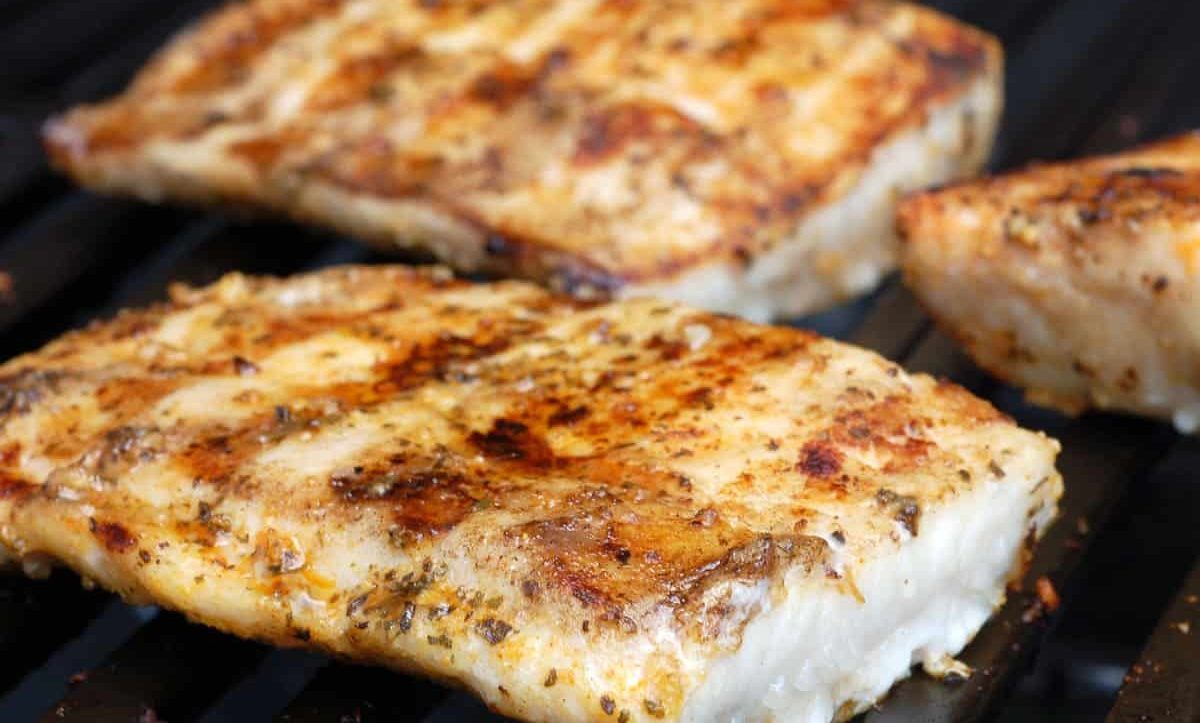
Popular Mahi Mahi Recipes
Mahi Mahi is a highly sought-after fish in tropical and subtropical waters worldwide. It is known for its firm texture, mild flavour, and bright colours when cooked. Many popular recipes feature mahi mahi, ranging from simple dishes to more complex creations.
First, mahi mahi tacos are readily prepared by cooking the fish with spices and then combining it with shredded cabbage and other vegetables, drizzling with lemon garlic sauce. The tacos can be soft or hard, depending on preference.
Secondly, grilled mahi mahi with mango salsa is a flavorful summer dish that takes advantage of the freshness of seasonal fruits like mangoes and avocados.
Finally, ceviche with tomato and cucumber is a classic preparation that uses citrus juices to ‘cook’ the fish without heat.
These three recipes showcase how versatile mahi mahi can be in various dishes. Whether cooked on the grill or served raw in a ceviche, this fish can take centre stage in any meal. Serve immediately.
As its popularity continues to grow among home cooks and professional chefs alike, creative new recipes featuring this delicious fish can be expected from all corners of the culinary world.
Comparison To Other Fish
Mahi mahi is a popular fish that is enjoyed by many around the world. It has some distinct characteristics that make it stand out among other species. By comparing imported mahi mahi to other fish, one can better understand the unique qualities that make this type of fish so desirable.
Firstly, when compared to other fish, mahi mahi stands out due to its mild flavour and firm texture. This makes it an ideal option for various dishes ranging from grilled frozen fillets to ceviche. Additionally, unlike other fish in the ocean, mahi mahi are low in mercury content, making them a safe and healthy choice for consumers.
Secondly, one of the key characteristics of mahi mahi is its versatility. This type of fish’s mild taste and firm texture allows it to be cooked in various ways without losing its flavour or texture. Some popular methods include grilling, baking, broiling, steaming and poaching. Furthermore, since it pairs well with diverse flavours such as citrus fruits and herbs, it can easily be incorporated into many recipes without overpowering the dish.
History of Mahi Mahi
Mahi mahi is thought to have been around for millions of years, although its exact origin is still unknown. It is known to be a schooling fish, with adults forming large schools in the open ocean during the spawning season. Mahi Mahi is also known for their ability to quickly adapt to changing environmental conditions, including temperature and salinity. This ability has allowed them to thrive in many habitats worldwide, including tropical reefs, estuaries, and even colder coastal waters.
One of the most exciting aspects of its history involves its relationship with humans. The species has been caught commercially since at least the early 19th century, when it was primarily used as bait by fishermen in some parts of North America and Europe. Today, mahi mahi is highly sought after as a food source due to its light flavour and firm texture; it can be eaten fresh or cooked in various ways by different cultures across the globe. It is also popular among recreational anglers as a sportfish due to its size and strength when hooked on a line.
Given its long history, it is no surprise that mahi mahi has played an integral role in many cultures worldwide for centuries. With its resilience and adaptability, this species will likely continue to be an essential part of our lives for many years.
Conclusion
Overall, Mahi Mahi offers a unique culinary experience with its mild flavour and firm texture. Practising sustainable fishing when catching these fish is crucial to preserving their ocean population levels.
